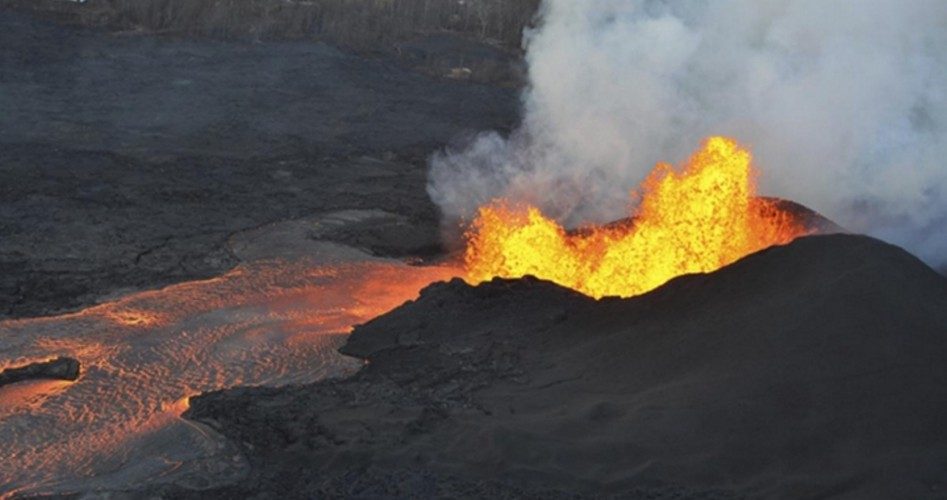
The eruption of the Kilauea volcano on the big island of Hawaii is leaving lasting effects on the 50th state.
According to data provided by the U.S. Geological Survey, the lava pouring out of Kilauea will actually add land to the island, making the state of Hawaii larger than before the explosion.
While the USGS is unwilling to estimate how much new land will be created by the eruption, in a statement tweeted on May 30, the agency did report that for the sake of comparison, “the 1960 Kapoho flows added 2 square km (0.75 square mil) to the island.”
The USGS website provides the following information on the 1960 eruption and subsequent land expansion:
After traveling 3.2 km, lava flows reached the ocean on January 15. Before the end of the day, new land extended 100 m beyond the old shoreline. Flows moved southward to slowly consume Higashi Pond over the course of four days (Jan 19 map). Warm Springs, a swimming and picnic area along the Kapoho fault, was overrun by lava flows even after bulldozers scraped together a 450-m-long, 1.5-3-m-high rock dike with the hope of diverting the lava flow.
Barriers were built in an attempt to stop the lava flows before they could inundate a school, Coast Guard facilities, and residences. Two barriers were easily shoved aside and overtopped by ‘a‘ā flows. A third barrier, more than 5 m (15 ft) high along its 450 m (500 ft) length, was constructed along the high saddle between the western base of Pu‘u Kūkae and Kapoho Crater, just northwest of Kapoho School.
On January 21, construction began on a 1.6 km (1 mi) long barrier along a broad forested ridge that stretched nearly to the ocean. The hope was that lava would neither engulf Kapoho Beach Lots nor the Coast Guard facilities at Cape Kumukahi. The wall held back lava for about a week. However, flows eventually breached it in several spots and destroyed the Coast Guard residences, but the lighthouse was spared. During the night of February 3-4, lava destroyed six houses in the Kapoho Beach Lots before the flow ceased early on February 5.
When the eruption was all over, lava flows covered more than 10 km2 (4 mi2), including 2 km2 (0.75 mi2) of new land beyond the original shoreline (see final map). The volume of lava erupted is conservatively estimated as 122 million m3 (160 yd3) with an additional 7.5 million m3 (10 yd3) of pyroclastic material.
So, while the USGS can’t say for certain how much new land will be created by the devastating flow of lava, there is relatively recent historical evidence that it will be substantial.
For constitutionalists, the curious question of constitutional importance is who will own the new land formed by the cooling contents of the crater.
The land around the Kilauea volcano — including the volcano itself — is part of the Hawaiʻi Volcanoes National Park and is thus controlled by the federal government.
On August 1, 1916 Woodrow Wilson signed a resolution creating the national park, which covers 323,431 acres and includes not only Kilauea, but Mauna Loa, too.
In light of this more than century-old designation, many commentators assume the federal government gains control of any new land created by the eruption of Kilauea.
The advocates of the federal ownership theory opine that as the state of Hawaii was admitted to the union in 1959, all land not privately owned at that time retroactively fell under the default ownership of the “people of the United States,” which is statist shorthand for: the federal government!
There is another side to the debate, though. This position holds that new ground created within the territory of a state belongs to the state, not to the federal government.
In the decision handed down by the Supreme Court in the case of Escanaba Co. v. City of Chicago, 107 U.S. 678, 689 (1883), an important constitutionally based concept known as the “equal footing doctrine” was described as “Equality of constitutional right and power is the condition of all the States of the Union, old and new.”
Basically, this principle requires that any state added to the union do so on equal footing with the 13 original states. As reported by the legal website Justia, “Since the admission of Tennessee in 1796, Congress has included in each State’s act of admission a clause providing that the State enters the Union ‘on an equal footing with the original States in all respects whatever.’”
Then there is the Supreme Court case of Pollard’s Lessee v. Hagan, decided in 1845. Justia provides a short, helpful summary of the events:
Pollard’s Lessee involved conflicting claims by the United States and Alabama of ownership of certain partially inundated lands on the shore of the Gulf of Mexico in Alabama. The enabling act for Alabama had contained both a declaration of equal footing and a reservation to the United States of these lands.
Rather than an issue of mere land ownership, the Court saw the question as one concerning sovereignty and jurisdiction of the States. Inasmuch as the original States retained sovereignty and jurisdiction over the navigable waters and the soil beneath them within their boundaries, retention by the United States of either title to or jurisdiction over common lands in the new States would bring those States into the Union on less than an equal footing with the original States.
This, the Court would not permit.
‘Alabama is, therefore, entitled to the sovereignty and jurisdiction over all the territory within her limits, subject to the common law, to the same extent that Georgia possessed it, before she ceded it to the United States.
To maintain any other doctrine, is to deny that Alabama has been admitted into the union on an equal footing with the original states, the constitution, laws, and compact, to the contrary notwithstanding….
[T]o Alabama belong the navigable waters and soils under them, in controversy in this case, subject to the rights surrendered by the Constitution to the United States; and no compact that might be made between her and the United States could diminish or enlarge these rights.’
The bottom line, then, whether Kilauea creates one acre of new land or a thousand, is this: The insistence that the land was retroactively ceded to the federal government when Hawaii became a state notwithstanding, the Constitution, common law, and relevant Supreme Court rulings point in another direction — that of state ownership.
Photo: U.S. Geological Survey



